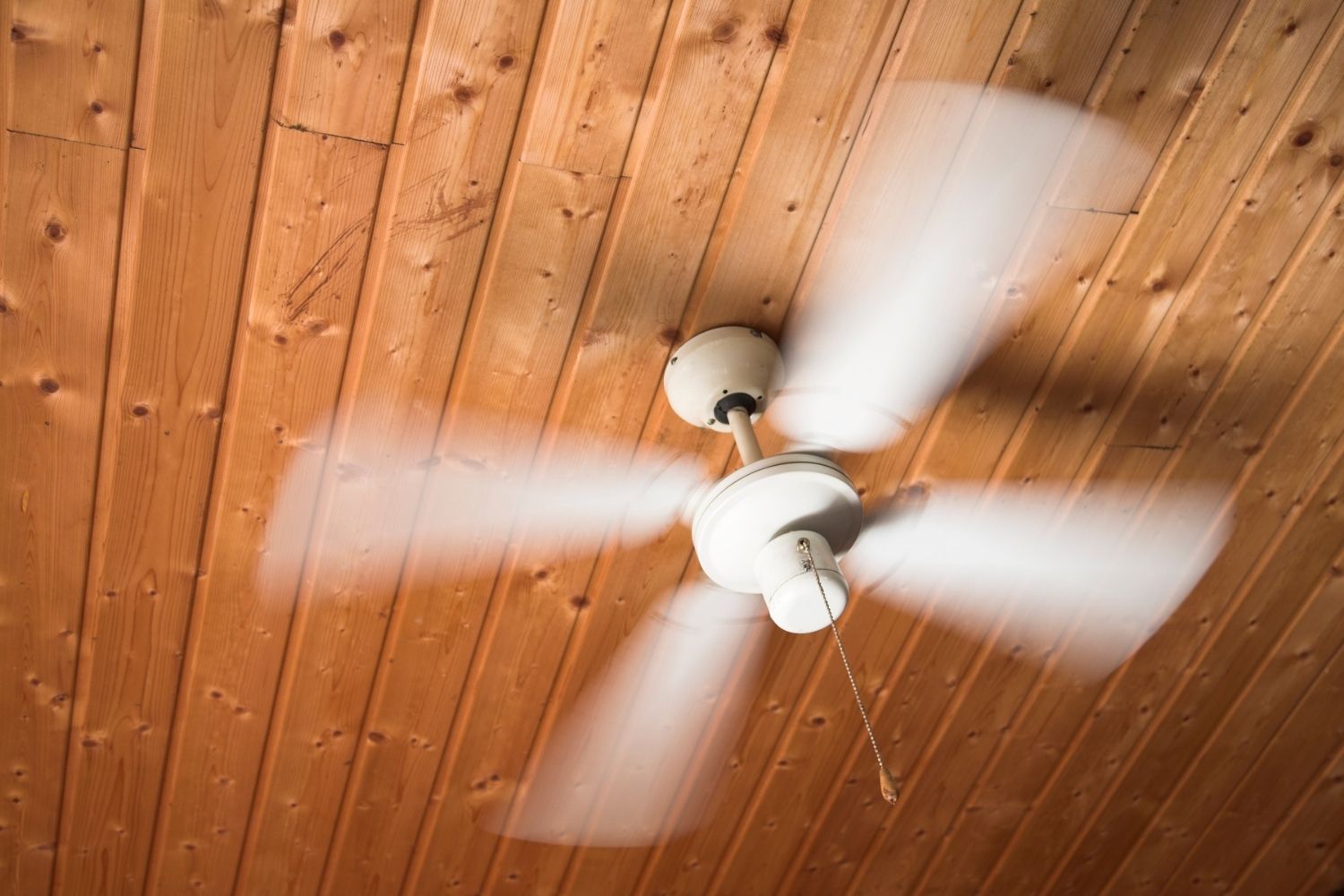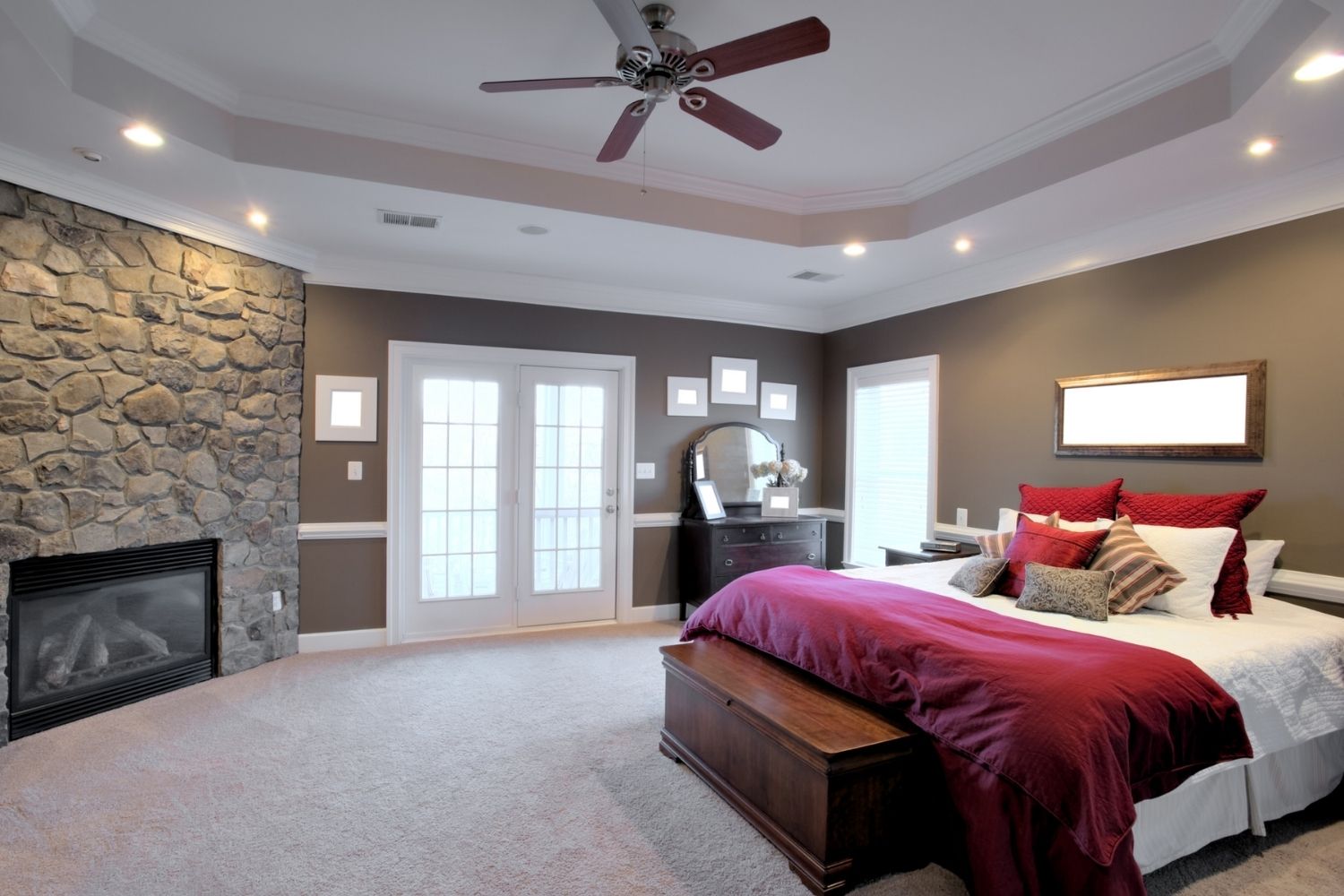We may earn revenue from the products available on this page and participate in affiliate programs. Learn More ›
Most people rely on their ceiling fan to bring a welcome breeze when temperatures heat up, as the devices make folks feel cooler by circulating the air. But these practical, energy-efficient fixtures—invented back in the late 19th century, introduced to American homes in the 1920s, and still popular today, despite the proliferation of air conditioning—can also make your home feel noticeably warmer when chilly weather sets in. What’s more, using your ceiling fan correctly throughout the year can help lower your energy bills.
The key to getting the most out of a ceiling fan is to change the direction of the blades’ spinning motion, reversing the air flow to suit your needs according to the season. Read on for the fan direction 411, as well as important info on the span and pitch of fan blades, to maximize these popular devices all year long.
Ceiling Fan Direction Summer vs. Winter
Mounted in the center of a ceiling and capable of spinning at a variety of speeds, ceiling fans circulate the air and thereby affect how cool or warm a space feels, without actually changing the temperature. Here’s how their function in different seasons stacks up.
The Spin on Summer
In warm weather, the blades of a ceiling fan should turn counterclockwise. This produces a current that moves down and out, which then sends air back up along the walls. Redistributing the air throughout a room in this way works because cooler air naturally pools near the floor while hot air rises; the blades’ counterclockwise spin moves cooler air to a level where you can feel it on your skin. This concept is known as the wind chill effect. Of course, since the temperature in the room is not actually lowering, it’s best to turn off the ceiling fan when people and pets aren’t present to enjoy the benefit.
Pro tip: Ceiling fans are only considered safe in rooms with 8-foot ceilings or higher, for the safety of people walking around in the room. But to maximize their efficiency, make sure your blades hang 10 to 12 inches below the ceiling and somewhere between 7 and 9 feet from the floor.

The Whirl on Winter
It might seem counterintuitive to turn on a fan when you want to get warm, but in fact, a ceiling fan can help to maintain comfort during the winter. A fan set to move clockwise (opposite the direction for summer) and run at low speed creates an updraft. This pulls cold air up to the ceiling and more evenly distributes the warmth the room receives from your central heating system, space heater, or fireplace. The fan moves the air to keep things cozy throughout your living space instead of letting cold pockets settle anywhere.
Again, the temperature isn’t actually changing; it just feels that way—so, as in the summer, turn the ceiling fan off when exiting the room.
Pro tip: There are ceiling fans with built-in space heaters on the market, and while they may not save you energy or money, they can solve the problem of a perennially cold room when central heat can’t effectively do the job.
Correct Ceiling Fan Direction Can Cut Energy Costs
Operating a ceiling fan correctly can help lower your utility bill. According to the U.S. Department of Energy (DOE), if you use air conditioning during hot weather, a ceiling fan will allow you to raise the thermostat setting about 4°F with no reduction in comfort. In temperate climates, or during moderately warm weather, ceiling fans may allow you to avoid air conditioner use altogether.
Reversing fan direction in winter can also save energy because it will keep warm air, which naturally rises, down at the level where people gather. This can allow you to turn the thermostats down a bit without feeling noticeably colder. Ceiling fan manufacturers claim that doing this consistently and correctly can reduce heating bills by up to 15 percent. For extra savings, run the fan at a lower speed in winter.

How Is Ceiling Fan Efficiency Measured?
For maximum savings from a ceiling fan, consider the unit’s efficiency rating, which is determined by how much airflow it creates compared to the amount of electrical energy it uses. Airflow rating is measured in cubic feet per minute (CFM) per one watt (W) of electrical power while the fan is running at high speed. The higher the CFM, the more energy efficient the fan will be. A very inefficient ceiling fan would have a CFM of about 75, while an efficient model will have a CFM in the 4,000 to 5,000 range, and the best CFM is 6,000 or more.
Blade Span and Pitch
Blade span and pitch are both factors worth considering when it comes to ceiling fan efficiency. Generally speaking, the larger the blade span, the more efficient the fan will be. Medium-sized rooms of between 144 and 225 square feet should do well with a fan blade span between 44 and 50 inches.
Blade pitch refers to the angle at which the blade is set in relation to the fan, and it determines how well the blades will rotate. For blades to whip the air enough to get it circulating around the room, optimum pitch is between 12 and 14 degrees. Blades set at a lower angle will slice the air without producing adequate air circulation, while those pitched too high meet too much resistance, potentially causing the motor to burn out.

How to Change Your Ceiling Fan Direction
Nearly every ceiling fan has a switch on the motor housing that changes the blades’ movement from counterclockwise (the standard setting) to clockwise, and vice versa. When winter’s chill hits your home, first check your wall panel (if your model uses one) for a reverse-direction setting, which is the easiest way to flip from summer mode to winter mode. Press it once and look up at the fan to ensure that the blade direction has reversed.
If your ceiling fan does not operate via a wall panel, you’ll need to change the direction manually. Turn the fan off, wait for the blades to stop moving completely, and climb a sturdy ladder to reach the small switch on the motor housing. If the switch isn’t immediately visible, check the top of the motor housing, above the blades; remember, the fan must be off and completely still, lest you risk injury. Flip the switch, climb down, and turn the fan on low, then give it a glance to ensure it’s running in the desired direction.
Pro tip: Very few, if any, ceiling fans are made without a direction switch on the motor housing, so if you’re stymied, consult the manufacturer. And if you’re in the market for a new ceiling fan, make sure it has a direction switch and learn its location.

FAQ About Changing a Ceiling Fan Direction
How can you tell if a fan is going clockwise or counterclockwise?
Gaze up at the ceiling while it is running on a low setting and watch the blades spin. If they turn to the left—the standard setting, appropriate for warm weather—the fan is going counterclockwise. If the blades turn to the right, the fan is turning clockwise, the ideal cold-weather setting/
When should I clean my ceiling fan?
Ceiling fans blades can collect a lot of dust, so the ideal time to clean them is twice a year, when you change the direction. While standing on a secure ladder, insert the blades, one at a time, into a clean pillow case and gently wipe both sides clean while drawing the case off the blade. For kitchen ceiling fans that have accumulated grease and dirt as well as dust, the blades may require removal with a screwdriver for cleaning with mild soap and water.
How do I change the direction of my ceiling fan without a switch?
If there is no switch on the fan housing, use the remote control and the light switch on the wall used for the light on the fan fixture. With the light switch on, hold the fan button down (on position), then turn the light switch off, then on again, and release the button on the remote. Then turn the fan on again, using the remote, and the blades should turn in the opposite direction.
Should ceiling fans be left on all the time?
Most ceiling fans are designed to operate 24/7, but they should only be left on when there are people or pets in the room to enjoy the benefit of feeling cooler or warmer.
To learn more about changing the direction of your ceiling fan, check out this video:


